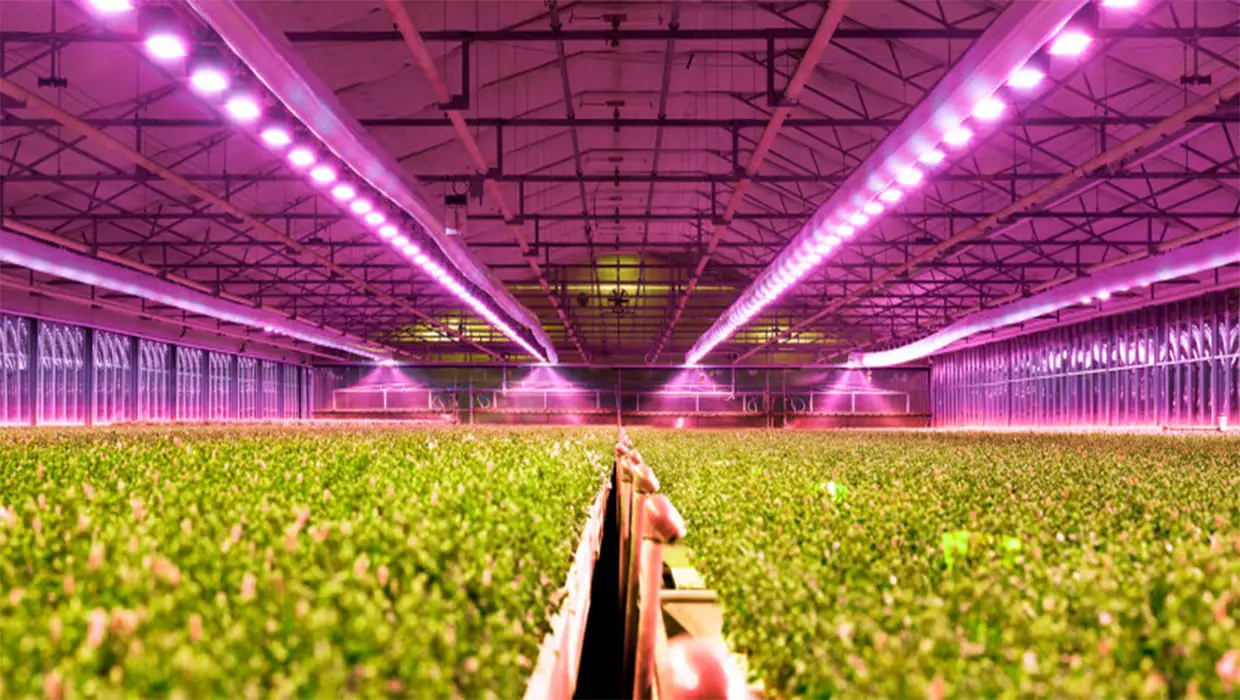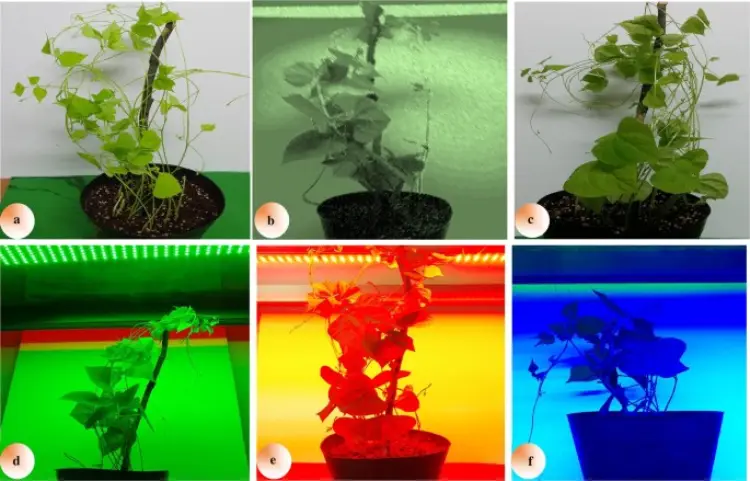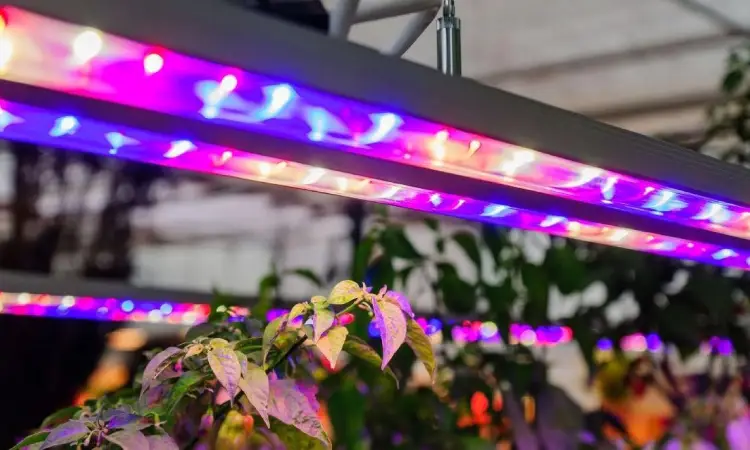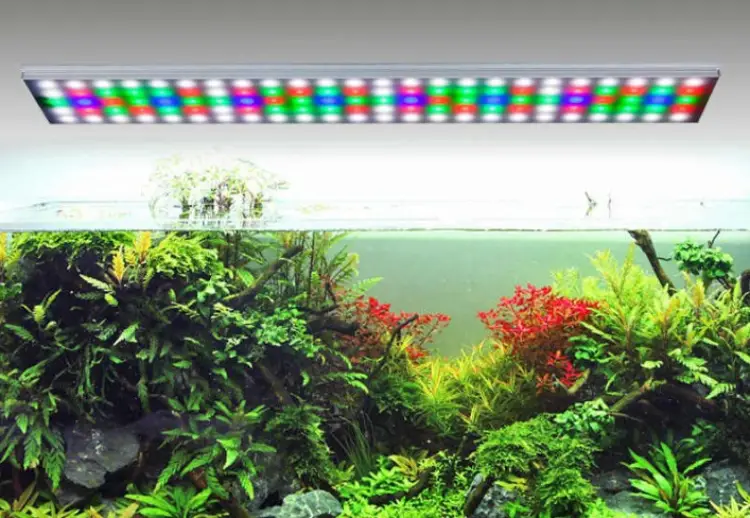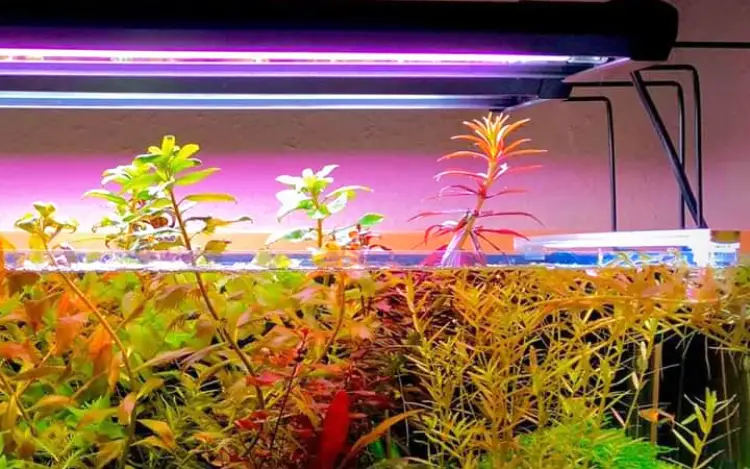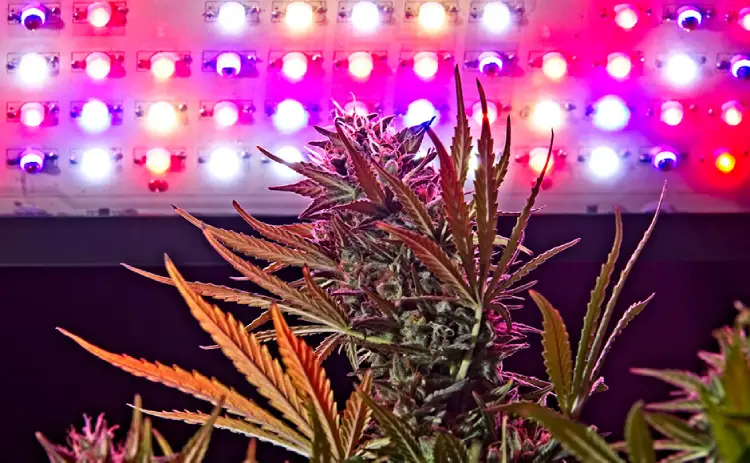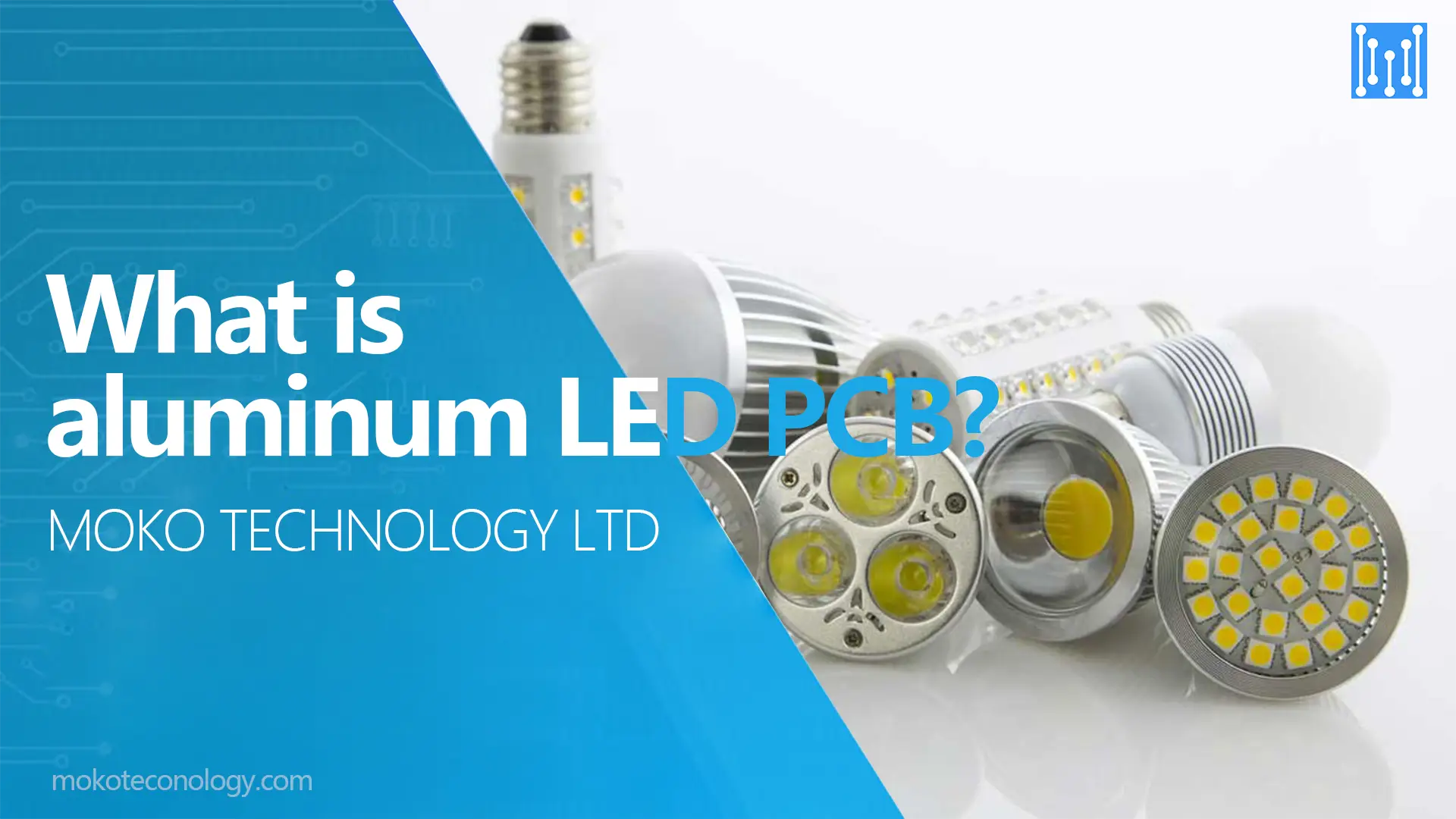Maintenant, agricultural lighting is used in microbial microalgae cultivation, edible fungus cultivation, poultry breeding, aquaculture, crustacean pet care, and the most widely used plant cultivation, with more and more application fields. Especially the plant LED light, after the rapid development of the indoor planting of plants, and the rapid development of greenhouse planting, it has entered a stage of rapid development.
Types of plant light
Maintenant, there are many types of plant lighting fixtures on the market, mainly LED lamps, high-pressure sodium lamps, incandescent lamps, and fluorescent lamps. Each kind of growth lamp has its own unique advantages. Avec le développement de la technologie, the advantages of LED are becoming more and more obvious. Plant LED light has the advantages of high efficiency, longue vie, low heat, and no environmental pollution. Plant LED light is used in plant lighting. The market gradually replaced other types of plant lights.
Usine LED light market distribution
The plant lighting market is getting bigger and bigger, especially some densely populated countries (such as China, South Korea, Japan, etc.) and countries where outdoor environments are not conducive to planting (such as the Middle East, Canada, etc.) are vigorously developing indoor planting and greenhouse planting . Depuis 2013, LED lighting technology has gradually matured and its market share has become larger and larger, with an average annual compound growth rate of more than 30%. The scale of the global plant light market is still increasing. The scale in 2020 is already over 19.12 million square meters. Increasingly large plant factories use plant lights as the main indoor lighting fixtures.
the application field of plant light
The field of plant lighting is one of the important directions for the development of modern agriculture. The effect of light on plant growth and development is reflected in two aspects. One is to provide energy and material for plant photosynthesis, and to promote the accumulation of plant organic matter, and the other is to provide signals for plant growth and development. Plants have formed a kind of Through the understanding of light to judge the changes of the seasons and make corresponding changes. Through the function of light, plant lighting can be divided into growth lighting and signal lighting. Growth lighting is to replace sunlight and provide energy for the growth of plants; signal lighting can promote germination, florescence, and color lights for plants. In terms of application areas, plant lighting mainly includes seedling lighting, gardening landscape, plantation en serre, plant factories and so on.
the technical requirements of plant lighting users
Plant lighting is a high-tech, multi-field industry, and the growth state of plants is related to many factors. Plants want to grow healthily, and planting should not only pay attention to the lighting part of the plant but also pay attention to other factors such as temperature and soil. The technical requirements of plant lighting are mainly divided into the following two angles: (1) Look at the technical requirements from the perspective of the layout of patents.
The layout of the patents reflects a certain extent the judgments of enterprises, scientific research institutes, and experts on technological development, which can reflect the technical needs and demand trends of plant lighting users to a certain extent; (2) Look at the technical needs from the user’s point of view.
Looking at technical requirements from the perspective of patent layout
Among the patents applied for in the field of Plant LED light applications, the top 5 IPc technology classifications are
(1) F21Y101/02: related to miniature light sources, such as light-emitting diodes or lighting systems;
(2) A01G9/20: Use light to cultivate flowers, vegetables or rice in the facilitating hotbed;
(3) F21s2/00: non-portable lighting device or system of modular structure, etc.;
(4) A01G7/04: Treat plants with electricity or magnetism to promote their growth. Promote plant growth through the use of electromagnetic radiation. It has obvious optimization of the light source, system, structure and device of the plant lighting, making the plant lighting more intelligent, which reflects to a large extent that the simplification of the use of plant lighting meets the needs of users
See technical requirements from the user’s perspective
The growers’ acceptance and dependence on plant lighting determines the development of the industry to a large extent. For users, the cost and benefits of use are their key concerns.
Looking at technical requirements from the cost of plant LED light
The price of LED lights is related to user acceptance. LED is at a disadvantage in price, and the price is high. The price of plant LED light with the same power is 7 times that of high-pressure sodium lights. Based on the analysis of MOKOLumière‘s sales data of plant lights from 2016 to the present, from the perspective of the sales proportion of lamps with different powers, the sales of lamps below 50w accounted for 68% of the total number. Most new customers prefer to try small-scale lamps with low power.
In the cost of lamps, in addition to the lamp housing and driving costs, the cost of lamp beads is more expensive than ordinary lamp beads. Take the 2835 lamp beads of 0.2wd as an example, the price of plant lighting lamp beads is about 4-7 times that of general lighting lamp beads. With the development of technology and craftsmanship, the price of LED lamp beads is gradually decreasing. The use of new low-cost materials has further reduced the price of LED lamp beads, and the manufacturing speed of wicks has become faster and also lowered costs.
Looking at technical requirements from the cost of using plant LED light
Power cost and power efficiency are basically the issues that every plant light user is concerned about. Electricity efficiency refers to the output rate of electricity at a point. The output here refers to the two aspects of output and quality.
Lumière
Light is one of the main factors that affect the growth and development of plants, and the spectrum, intensité lumineuse, and photoperiod affect the growth and development of plants.
- Spectre
The radiation with a wavelength range of 300-800nm is called physiologically active radiation of plants, but UVB (280-320nm) and UVc (220-280nm) bands have effects on the growth and development of plants (the production of secondary metabolites). influences. On monochromatic lamp beads, the physiologically effective radiation wavelengths of plants basically cover, and plant lamp manufacturers generate different applicable spectra through the combination of different lamp beads. Lamp beads in the UV band are rarely used for plant lighting, mainly because of their complicated manufacturing process and high cost of use.
Although the spectrum can be diversified by array combination of monochromatic lamp beads or chip excitation of phosphors. Different types of plants have different requirements for the spectre at different stages. Take the customer requirements of Lv Ai for example: Except for the red and blue regions, the content of the 730nm far-red light band is within the design range of the spectrum, and the customer has clear requirements for energy-saving effects, and this is for the accuracy of the spectrum. The requirements for performance and high efficiency of the lamp beads are very high; the spectrum of the tissue culture lamp, under the premise of ensuring the growth effect, in order to facilitate the timely and clean treatment of contaminated seedlings, the color rendering index of the tissue culture lamp (Ra≥80) There are requirements; it is also a growth lamp. The indoor plant lamp and the greenhouse fill light have different light quality and content; compared with the growth lamp, the spectrum design of the nursery lamp pays more attention to the seedling index of the seedling.
Plant lighting users have many types of plants. The crop information provided by the customers of Green Love includes red quinoa, salad lettuce, iced vegetable, dragon fruit, passion fruit, strawberry, tomato, concombre, rose, okra, dendrobium, Anoectochilus, tissue culture seedlings, tobacco seedlings, sweet potato seedlings, okra, chanvre, succulentes, etc.. They are not necessarily all professional in distinguishing and cognition of spectrum, but they are the primary concern for planting effect data. Some users are very interested in plant lighting products that mimic sunlight and think that the spectrum of sunlight is similar to that of sunlight. Compared with the solar spectrum, artificial light sources have lower diversity and accuracy. Only increasing the power of artificial light sources can meet the needs of plants.
- Light intensity
The light intensity has a greater impact on plants. En général, the light intensity near the saturation point of light is most beneficial to the growth of plants. Different crops have different light compensation points at different stages. From the perspective of the plant factory’s supplemental light intensity, the light intensity in the seedling stage should be slightly lower, at 60-200 µmol/(m2·s), and then gradually increase. Leafy vegetables can reach up to 100~200μmol/(m2·s), and fruit vegetables can reach 300~500μmol/(m2·s).
In terms of light intensity, the demand for light intensity of the signal plant lamp is significantly lower than that of the growth lamp as energy.
The signal light only provides signals and induces changes in the state of plants. If the light intensity is too large, it will affect the growth of the plants. The effective light intensity (PPFD) is below 3-30μmol/(m2.S)
- Light effect
Light efficiency is the ability of plant lights to convert electrical energy to light energy. The light efficiency is high, the efficiency of converting electric energy into light energy is high, the electric energy usage is less, and the electric power cost is low. The grower not only depends on the power of the plant light, but also the overall light effect of the plant light (unit: µmol/J). Manufacturers should work hard to improve the craftsmanship, design, and materials to increase the luminous efficiency of plant lights. lumière rouge (660nm) perles de lampe, the luminous efficiency on the market is as high as 3.17μmol/J, and the blue light (450nm) luminous efficiency is about 2.5μmol/J. The light effect of the lamp beads in the purple band is low. The highest luminous efficiency of mixed-color lamp beads is about 2.5 µmol/J.
- How the light is used
Plant lighting, instead of sunlight, but it is completely controllable. The day’s light time, intensité lumineuse, and spectral changes are all controllable. Cependant, the saturation point of plant light cannot be controlled. We must always pay attention to the change of the plant light saturation point to avoid the waste of light intensity greater than the plant saturation point. The total amount of light that plants receive in a day is limited, and the light absorption rate of plants above this value is very low. En ce moment, because of the light, so as to avoid waste of energy.
System plan
Indoor cultivation is relatively expensive, and crop yields must be high to recover the cost. The indoor planting environment can be controlled. The growth state of the plant can be controlled by controlling the temperature, humidité, carbon dioxide concentration, light and the substance content in the nutrient solution in the plant growth environment.
Expert planting technology. Plant factories are different from traditional planting methods. Whether it is people in other professions, or traditional agricultural professionals, investing in or managing plant factories, expert planting technology needs and guidance are indispensable. The growth and development of plants are closely related to the environment. The interaction of factors such as light, eau, nutrients, and air in the environment determines the growth state of plants. Maintenant, there is a certain accumulation of information on the interaction between light and temperature, the interaction between light and air content, and the interaction between light and nutrient elements, but there are very few data on the interaction of more factors. The indoor planting system is designed based on the growth environment of plants, and professional growth plans need more plant growth data to support.
Others
Waterproof level, light-emitting angle, dissipation de la chaleur, lamp life, light decay and other parameters of plant lighting tools are important technical factors that determine whether plant lights can be widely used.
Conclusion
With the maturity of LED lighting technology, the decline of LED costs, the intervention of scientific research forces and government policies, many companies have shifted from the fiercely competitive general lighting market to the field of plant lighting. The products are messy, the production design is not standardized, and the sales spectrum lacks actual verification, which gradually reduces the public’s trust in the plant lighting industry and slows down the market expansion and maturity of the plant lighting industry. MOKOLight has been researching plant LED light since 11 années. It has a professional production line, professional engineers and a strong R&D team, which can meet the various needs of customers.
